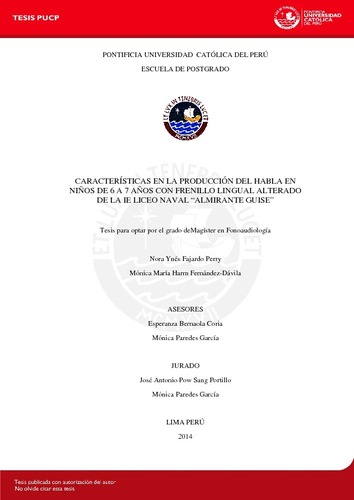| dc.contributor.advisor | Bernaola Coria, Esperanza | |
| dc.contributor.advisor | Paredes García, Mónica | |
| dc.contributor.author | Fajardo Perry, Nora Ynés | es_ES |
| dc.contributor.author | Harm Fernández-Dávila, Mónica María | es_ES |
| dc.date.accessioned | 2014-12-18T15:46:49Z | es_ES |
| dc.date.available | 2014-12-18T15:46:49Z | es_ES |
| dc.date.created | 2014 | es_ES |
| dc.date.issued | 2014-12-18 | es_ES |
| dc.identifier.uri | http://hdl.handle.net/20.500.12404/5781 | |
| dc.description.abstract | The following is a simple descriptive study, whose main objective is to
determine the features in speech production in children aged 6 to 7 with a lingual
frenulum alteration.
To collect data we used the Tongue Frenulum Evaluation Protocol of Irene
Marchesan and the systematic observation technique, in order to classify different
lingual frenulum types, as well as identify the characteristics in the speech
production to a population of 109 children aged 6 to 7 years of the school Liceo
Naval Almirante Guise, in the district of San Borja.During this process a
photographic and video recordwas carried out.
The results of the study show that 88% of the studied population,
presented a normal lingual frenulum and 12% (13 children) presented altered
lingual frenulum. The most frequent alterations were a short frenulum for 5.50%
of cases, followed by the short with anterior insertion, in 4.59% and the anterior
insertion on 1.83% of the cases. Of the from children who show altered lingual frenulum, 77% present
speech disorders, being the more frequent distortions (76.92%), followed by
substitutions (46.15%) and omissions (38.46%). The speech sounds which
presented alterations in their production were /r/, /ɾ / and their consonant clusters.
Altered frenulum that cause problems are the short lingual frenulum and
the short with anterior insertion. These problems include speech disorders,
alteration in the tongue tip (apex) during their elevation and the proper
performance of tongue mobility | en_EN |
| dc.description.abstract | El presente es un estudio descriptivo simple, cuyo objetivo principal es
determinar las características en la producción del habla en niños de 6 a 7 años
que presentan frenillo lingual alterado.
Para el recojo de los datos se utilizó el Protocolo de Evaluación del
Frenillo de la Lengua de Irene Marchesan y la técnica de observación sistemática,
con la finalidad de clasificar el tipo de frenillo lingual y las características en la
producción del habla,de una población de 109 niños de la IE Liceo Naval
Almirante Guise, del distrito de San Borja.Durante el proceso se llevó a cabo un
registro documentario, fotográfico y de video.
Los resultados de la investigación evidencian que un 88% de la población
estudiada, no presentaron alteración alguna en el frenillo lingual, mientras que un
12% (13 niños) presentó frenillo lingual alterado, siendo la alteración más
frecuente el frenillo corto en un 5.50% de los casos, seguidos del frenillo corto con fijación anteriorizada, en un 4.59% y del frenillo con fijación anteriorizada en
un 1.83%.
Así mismo, de los niños que presentan frenillo lingual alterado, un 77%
muestra alteraciones en la producción de habla, siendo las más frecuentes las
distorsiones (76.92%), seguida por las sustituciones (46.15%) y las omisiones
(38.46%). Los fones que presentan alteraciones en su producción son el vibrante
múltiple /r/, el vibrante simple /ɾ / y sus grupos consonantales.
Los tipos que frenillo alterado que ocasionan problemas son el frenillo
lingual corto y el corto con fijación anteriorizada. Estos problemas incluyen, la
producción del habla, la alteración de la forma del ápice de la lengua durante su
elevación y la adecuada ejecución de praxias linguales. | es_ES |
| dc.language.iso | spa | es_ES |
| dc.publisher | Pontificia Universidad Católica del Perú | es_ES |
| dc.rights | info:eu-repo/semantics/openAccess | es_ES |
| dc.rights.uri | http://creativecommons.org/licenses/by/2.5/pe/ | * |
| dc.subject | Trastornos del habla en niños. | es_ES |
| dc.subject | Niños--Lenguaje. | es_ES |
| dc.title | Características en la producción del habla en niños de 6 a 7 años con frenillo lingual alterado de la IE Liceo Naval "Almirante Guise". | es_ES |
| dc.type | info:eu-repo/semantics/masterThesis | es_ES |
| thesis.degree.name | Maestro en Fonoaudiología | es_ES |
| thesis.degree.level | Maestría | es_ES |
| thesis.degree.grantor | Pontificia Universidad Católica del Perú. Escuela de Posgrado | es_ES |
| thesis.degree.discipline | Fonoaudiología | es_ES |
| renati.discipline | 916117 | es_ES |
| renati.level | https://purl.org/pe-repo/renati/level#maestro | es_ES |
| renati.type | http://purl.org/pe-repo/renati/type#tesis | es_ES |
| dc.publisher.country | PE | es_ES |
| dc.subject.ocde | https://purl.org/pe-repo/ocde/ford#3.05.03 | es_ES |






